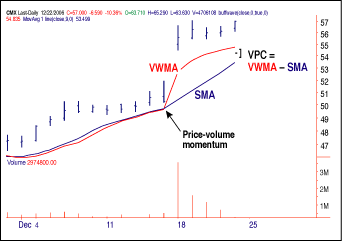Connection And Affinity
Between Price And Volume
When securities change hands on a securities auction market, the volume of shares bought always matches the volume sold. When the price rises, the upward movement reflects that demand exceeds supply or buyers are in control. Likewise, when the price falls it implies that supply exceeds demand or that sellers are in control. Over time, these trends of supply and demand form accumulation and distribution patterns. What if there were a way to look deep inside price and volume trends to find out if current prices were supported by volume? This is the objective of the volume price confirmation indicator (VPCI), a methodology that measures the intrinsic relationship between price and volume.
VOLUME PRICE CONFIRMATION INDICATOR
The VPCI exposes the relationship between the prevailing price trend and volume, as either confirming or contradicting the price trend. This gives an indication of possible impending price movements. In this article I will discuss the derivation and components of the VPCI and explain how to use it. I will also review comprehensive testing of the VPCI and present further applications using the indicator.
In exchange markets, price results from an agreement between buyers and sellers despite their different appraisals of the exchanged item's value. One opinion may have legitimate fundamental grounds for evaluation, while the other may be pure nonsense. To the market, however, both are equal. Price represents the convictions, emotions, and volition of investors. It is not a constant, but rather changed and influenced over time by information, opinions, and emotions.
Market volume represents the number of shares traded over a given period. It is a measurement of the participation, enthusiasm, and interest in a given security. Think of volume as the force that drives the market. Volume substantiates, energizes, and empowers price. When volume increases, it confirms price direction; when volume decreases, it contradicts price direction. In theory, increases in volume generally precede significant price movements.
This tenet of technical analysis, that volume precedes price, has been repeated as a mantra since the days of Charles Dow. Within these two independently derived variables, price and volume, exists an intrinsic relationship. When examined together, price and volume give indications of supply and demand that neither could provide independently.

FIGURE 1: DIFFERENCE BETWEEN SMA AND VWMA. The result of this calculation provides information about the relationship between price and volume.
...Continued in the July issue of Technical Analysis of STOCKS &
COMMODITIES
Excerpted from an article originally published in the July 2007 issue
of Technical Analysis of
STOCKS & COMMODITIES magazine. All rights reserved. © Copyright
2007, Technical Analysis, Inc.
Return to July 2007 Contents